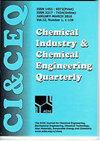交流平行板介质阻挡放电中乙烷一步转化为环氧乙烷
IF 0.8
4区 工程技术
Q4 CHEMISTRY, APPLIED
Chemical Industry & Chemical Engineering Quarterly
Pub Date : 2023-01-01
DOI:10.2298/ciceq230228026s
引用次数: 0
摘要
本文研究了在常温常压条件下,由两块磨砂玻璃板组成的交流平行板介质阻挡放电(DBD)系统中乙烷(C2H6)一步转化为环氧乙烷(EO)的过程。环氧乙烷直接由C2H6一步制得,不需要分离和回收乙烯。考察了施加电压、输入频率和O2/C2H6进料摩尔比对环氧乙烷合成性能的影响。结果表明,较高的施加电压和较低的输入频率会产生更多的高能电子,从而产生较大的电流。更多的电子与反应物气体分子碰撞,引发等离子体反应,导致C2H6和O2转化的增加。O2/C2H6进料摩尔比的增加提高了C2H6和O2的转化率。结果表明,在电压为7 kV,输入频率为550 Hz, O2/C2H6摩尔比为1:1的条件下,环氧乙烷选择性最高(42.6%),收率最高(19.4%),每分子环氧乙烷的功耗最低(6.7 x 10-18 w /分子)。本文章由计算机程序翻译,如有差异,请以英文原文为准。
One-step conversion of ethane to ethylene oxide in ac parallel plate dielectric barrier discharge
This work studied the one-step conversion of ethane (C2H6) to ethylene oxide (EO) in an AC parallel plate dielectric barrier discharge (DBD) system with two frosted glass plates under ambient temperature and atmospheric pressure. EO is directly produced from C2H6 in a single step without the requirement to separate and recycle ethylene. The effects of the applied voltage, input frequency, and O2/C2H6 feed molar ratio on the EO synthesis performance were examined. The results showed that a higher applied voltage and lower input frequency generated more highly energetic electrons, resulting in a higher current. More electrons collided with reactant gas molecules to initiate plasma reactions, leading to increases in C2H6 and O2 conversions. The increased O2/C2H6 feed molar ratio enhanced both C2H6 and O2 conversions. The optimum conditions were found to be an applied voltage of 7 kV, input frequency of 550 Hz, and O2/C2H6 feed molar ratio of 1:1, which demonstrated the highest EO selectivity (42.6%), EO yield (19.4%), and lowest power consumption per EO molecule produced (6.7 x 10-18 Ws/molecule).
求助全文
通过发布文献求助,成功后即可免费获取论文全文。
去求助
来源期刊

Chemical Industry & Chemical Engineering Quarterly
CHEMISTRY, APPLIED-ENGINEERING, CHEMICAL
CiteScore
2.10
自引率
0.00%
发文量
24
审稿时长
3.3 months
期刊介绍:
The Journal invites contributions to the following two main areas:
• Applied Chemistry dealing with the application of basic chemical sciences to industry
• Chemical Engineering dealing with the chemical and biochemical conversion of raw materials into different products as well as the design and operation of plants and equipment.
The Journal welcomes contributions focused on:
Chemical and Biochemical Engineering [...]
Process Systems Engineering[...]
Environmental Chemical and Process Engineering[...]
Materials Synthesis and Processing[...]
Food and Bioproducts Processing[...]
Process Technology[...]
 求助内容:
求助内容: 应助结果提醒方式:
应助结果提醒方式:


